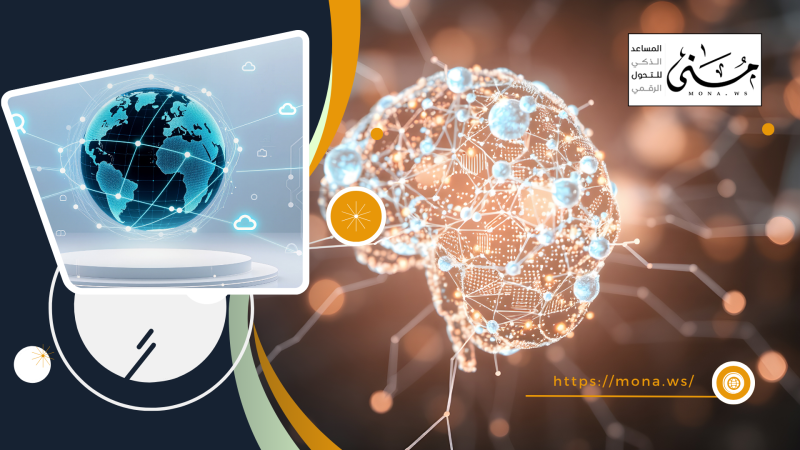In light of the rapid digital transformations taking place in industries and facilities around the world, the need to develop maintenance management methods has emerged beyond traditional models based on timetables or manual reports. Maintenance has become a vital component of ensuring business continuity, achieving operational efficiency, and reducing costs associated with unplanned downtime or the collapse of vital assets .
In this context, smart maintenance has emerged as a radical and innovative solution that combines artificial intelligence (AI) and the Internet of Things (IoT) To introduce a new approach based on proactive and predictive action rather than reaction. Engineers no longer need to wait for a device to malfunction before reporting it. Sensors connected to equipment can now send live data and immediate warnings, while artificial intelligence algorithms analyze this data and recommend preventative maintenance or even suggest technical alternatives .
The concept of smart maintenance does not simply mean digitizing technical work, but rather reflects a fundamental shift in the way we think about maintenance itself: from a tool to support production to a strategic pillar that helps protect investments and enhance the competitiveness of the organization .
This article highlights this shift and explores how AI technologies can be integrated. and IoT To open new horizons in smart maintenance management , focusing on the role of systems such as DocSuite CMMS In enabling organizations to achieve this trend, we will also discuss real-life examples and the benefits of implementing this model, along with the challenges that organizations may face on their path to this change .
The role of Internet of Things (IoT) technologies in data collection
Internet of Things technologies constitute The backbone of any smart maintenance infrastructure , this technology enables industrial devices and equipment to be connected to a digital network capable of exchanging data in real time. Advances in sensing and communication technologies make it possible to continuously and accurately monitor asset performance, without the need for constant human intervention .
IoT technologies work in a maintenance environment?
-
Installing smart sensors
The process begins with the installation of embedded sensors on critical assets such as motors, pumps, cooling units, pressure systems, etc. These sensors measure key variables, including :
-
-
temperature
-
Humidity
-
noise or vibration level
-
rotational speed
-
Energy consumption
-
Actual operating hours
-
-
Send data in real time
Sensors send their data periodically or instantly to a cloud-based digital platform or a central system within the organization. This is done via communication protocols such as :
-
-
Wi-Fi or Ethernet in smart factories
-
networks LoRaWAN or NB-IoT for wide-area environments
-
Bluetooth or Zigbee technologies in areas with limited coverage
-
-
Data analysis and performance comparison
Once the data is collected, it is analyzed by maintenance management systems ( such as DocSuite CMMS) or specialized artificial intelligence platforms. The system can then :
-
-
Identify trends and sudden changes in performance
-
Compare current values to reference values (Thresholds)
-
Monitor deviations that may indicate a malfunction or wear.
-
-
Create automatic alerts and crash reports
If the values exceed the permissible limits, the system generates an automatic fault report , which is sent directly to the technical team or maintenance manager, including :
-
-
Type of potential problem
-
Affected device data
-
Initial recommendation for the required action (inspection, maintenance, replacement)
-
Real-life examples of IoT use in maintenance
-
In industrial production lines, vibration sensors can detect the beginning of a crack in a drive shaft before it actually breaks, allowing maintenance without stopping production .
-
In central air conditioning systems, sensors can track energy consumption and identify leaks or blockages that affect efficiency .
-
In smart buildings, sensors are used to detect water leaks or sudden temperature spikes, preventing damage or fires .
Benefits of Using IoT in Maintenance Management
-
Improve forecast accuracy : by monitoring actual data instead of estimates .
-
Reduce downtime : by detecting problems before they develop .
-
Reducing operational costs : by eliminating unnecessary or delayed work .
-
Enhance transparency : by accurately tracking the performance and maintenance history of each asset .
-
Speed up response : thanks to automatic reports and instant alerts .
Integration with smart systems
IoT technologies are combined with systems like DocSuite CMMS , double value is achieved, as the platform can :
-
Automatically receive data from thousands of sensors
-
Scheduling maintenance based on actual indicators, not just timing.
-
Create analytical reports that support strategic decision-making.
Artificial Intelligence and Maintenance Foresight
Artificial Intelligence ( AI ) The second cornerstone of smart maintenance architecture integrates with data streams from IoT devices to analyze, interpret, and use them to predict failures and recommend optimal maintenance decisions. Thanks to its ability to process massive amounts of data quickly and accurately, AI is poised to revolutionize maintenance practices by shifting from traditional to predictive maintenance .
Historical and operational data analysis
Artificial intelligence (AI) collects and analyzes massive amounts of previously recorded equipment performance data, whether from sensors or from previous failure and maintenance records. By building advanced statistical models, the system can identify factors that typically precede failures, such as a gradual rise in temperature or a sudden drop in efficiency. This analysis helps understand the relationship between operating conditions and failure rates, providing a solid basis for intelligent forecasting .
Anomaly Detection
One of the most notable features of AI is its ability to identify "abnormal behavior" that traditional maintenance systems may not notice. For example, a subtle change in the vibration frequency of a particular engine could indicate the beginning of wear in a bearing. AI identifies these subtle signals and issues an early alert to take preventative action before the problem escalates .
Predicting failure before it happens
Using machine learning techniques, artificial intelligence builds predictive models that can determine when a device is likely to fail. These probabilities are estimated based on performance data and usage records. This enables the "remaining life" (RUL) of each component in the system to be determined , allowing maintenance to be scheduled at the most appropriate time, without unnecessary downtime or dangerous delays that could lead to equipment damage .
Suggesting smart maintenance procedures
AI's capabilities go beyond predicting failures, extending to suggesting practical actions tailored to the nature of the problem. For example, if the system detects a persistent increase in power consumption for a particular device, it may suggest checking the cooling components or cleaning the filters. It also sets a priority level for each action, so that critical failures are addressed first and secondary actions are postponed to avoid impacting business continuity .
Real-world applications of artificial intelligence in maintenance
Artificial intelligence is not an abstract theory; it is already being used in hundreds of industries around the world. In airlines, AI algorithms help predict hydraulic system failures, helping to avoid flight delays. In automotive factories, data is used to improve maintenance quality and reduce unplanned downtime. These real-world applications demonstrate the significant impact of AI on production readiness and service quality .
CMMS systems such as DocSuite In AI support
Maintenance management systems play a pivotal role in integrating artificial intelligence into daily maintenance operations. The DocSuite CMMS offers An advanced example of this integration is the ability to receive predictive outputs from AI models , convert them directly into work orders, and track them through to execution. It also offers interactive analytics that help managers evaluate the efficiency of maintenance operations and make informed decisions about resource optimization .
Strategic Benefits of AI- Driven Maintenance
When AI is integrated into the maintenance system, the benefits go beyond reducing breakdowns. Organizations achieve a quantum leap in efficiency by eliminating random tasks and directing efforts toward priority work. Having an accurate digital record of each asset also enhances compliance with industry standards and facilitates audits and management reporting. Ultimately, maintenance becomes a strategic tool that supports overall corporate performance .
Maintenance Management Systems (CMMS) and its role DocSuite
With the digital transformation, maintenance can no longer be efficiently managed based on paper or traditional schedules. Computerized Maintenance Management Systems ( CMMS) have emerged. As a comprehensive solution that enables organizations to fully control the lifecycle of assets and equipment, from registration to maintenance and documentation of their technical history .
Among these systems, DocSuite CMMS stands out. As an integrated platform that supports smart maintenance concepts, it provides advanced tools for reporting management, task scheduling, performance analysis, and integration with artificial intelligence and the Internet of Things .
What is a CMMS system ?
A CMMS is an electronic software used to manage maintenance activities through a digital interface. This system documents everything related to equipment and facilities, and enables the scheduling and implementation of maintenance activities in an organized manner, whether preventive, corrective, or proactive. It also provides periodic reports used for continuous evaluation and improvement .
The basic functions of any effective CMMS system include :
-
Equipment Management
-
Track Work Orders
-
Preventive Maintenance Scheduling
-
Recording maintenance and material costs
-
Preparing performance and maintenance reports
role DocSuite CMMS in Enabling Smart Maintenance
DocSuite CMMS features With several features that make it one of the leading solutions in the maintenance management market, especially when it comes to integration with artificial intelligence and Internet of Things technologies :
-
Direct connection with IoT devices
can: DocSuite Data is received from sensors and sensors embedded in equipment, enabling real-time monitoring of actual performance indicators. This data is automatically recorded and converted into proactive maintenance orders when necessary . -
Automatic fault alerts and reports
: When any deviation in operational values is detected, the system generates an immediate report containing all the fault details, which is forwarded to the relevant technician via a unified interface. The status of the report can also be tracked until it is closed . -
Intelligent scheduling for preventive maintenance.
The platform can schedule maintenance work based on time, operating hours, or smart indicators from sensors. The schedule is automatically reset when new tasks are performed or unexpected problems arise . -
Visual analysis and reporting
provided DocSuite An interactive dashboard displays equipment data, reports, maintenance team efficiency, and repair costs. This information can be used to identify the most costly or least efficient assets, supporting accurate strategic decision-making . -
Integration with artificial intelligence:
The system supports integration with AI algorithms capable of predicting failures and providing intelligent recommendations on the appropriate type of action and when to implement it. It can also calculate the remaining operational life of equipment and display it graphically .
Corporate benefits of using DocSuite CMMS
-
Improve operational efficiency : by reducing unexpected downtime and improving task scheduling .
-
Enhance transparency and follow-up : Every procedure is documented, and every device has a digital technical record .
-
Reducing costs : by reducing sudden breakdowns and optimal use of resources .
-
Achieving compliance and standards : Ability to generate reports ready for audit and quality control .
-
Supporting strategic decisions : through accurate analyses of performance indicators and risks .
Practical example
Suppose an industrial facilities operating company relies on DocSuite CMMS. As soon as a sensor in one of the motors detects a gradual increase in vibration, the system issues an immediate alert. Artificial intelligence analyzes the data and suggests a maintenance procedure within 72 hours to avoid unplanned downtime. The task is automatically scheduled and routed to the appropriate technician. After the maintenance is performed, the technical log is automatically updated, and repair costs are calculated .
In a world of accelerating change and fierce competition, maintenance is no longer merely a behind-the-scenes technical support process. Rather, it has transformed into a strategic element that directly contributes to business continuity, operational efficiency, and customer satisfaction. With the emergence of concepts such as smart maintenance , organizations are being required to rethink their traditional models and adopt digital solutions that keep pace with the times and invest in the future .
The integration of the Internet of Things (IoT) and artificial intelligence (AI) It opens up unprecedented horizons in maintenance management, as teams no longer need to predict failures based solely on experience. Instead, they can rely on accurate data and reliable predictive analytics, leading to more effective and proactive decisions. These transformations not only mean reduced breakdowns and lower costs, but also enhance production quality, prolong asset life, and improve the work environment .
On the other hand, computerized maintenance management systems (CMMS) , such as DocSuite , represent the bridge that connects these advanced technologies to the daily operations within an organization. They provide a flexible and customizable environment that helps technical and administrative teams coordinate and monitor, from fault notification to completion of a maintenance task, with the potential for documentation, automated analysis, and intelligent decision-making .
Despite potential challenges such as initial costs, resistance to change, or the need for systems integration, experience has shown that organizations that have taken the initiative to adopt smart maintenance have been able to achieve tangible results at all levels: operational, financial, and competitive .
In conclusion, the shift to smart maintenance is no longer a technical luxury, but rather a strategic necessity for every facility seeking excellence in asset management, ensuring its readiness, and keeping pace with future trends in digital transformation. Investing in smart systems such as DocSuite CMMS is a confident step towards this future .





Comments
Add New Comment